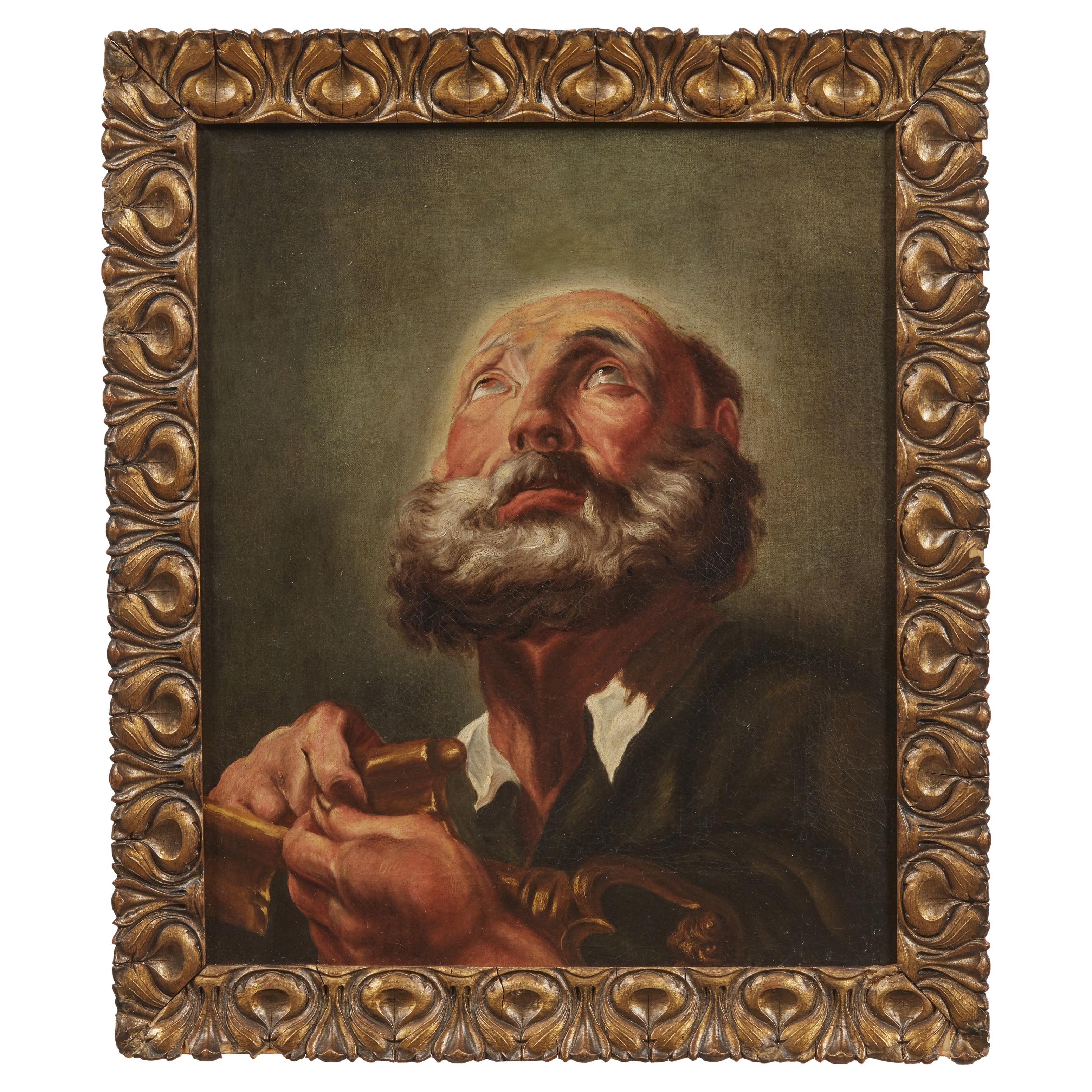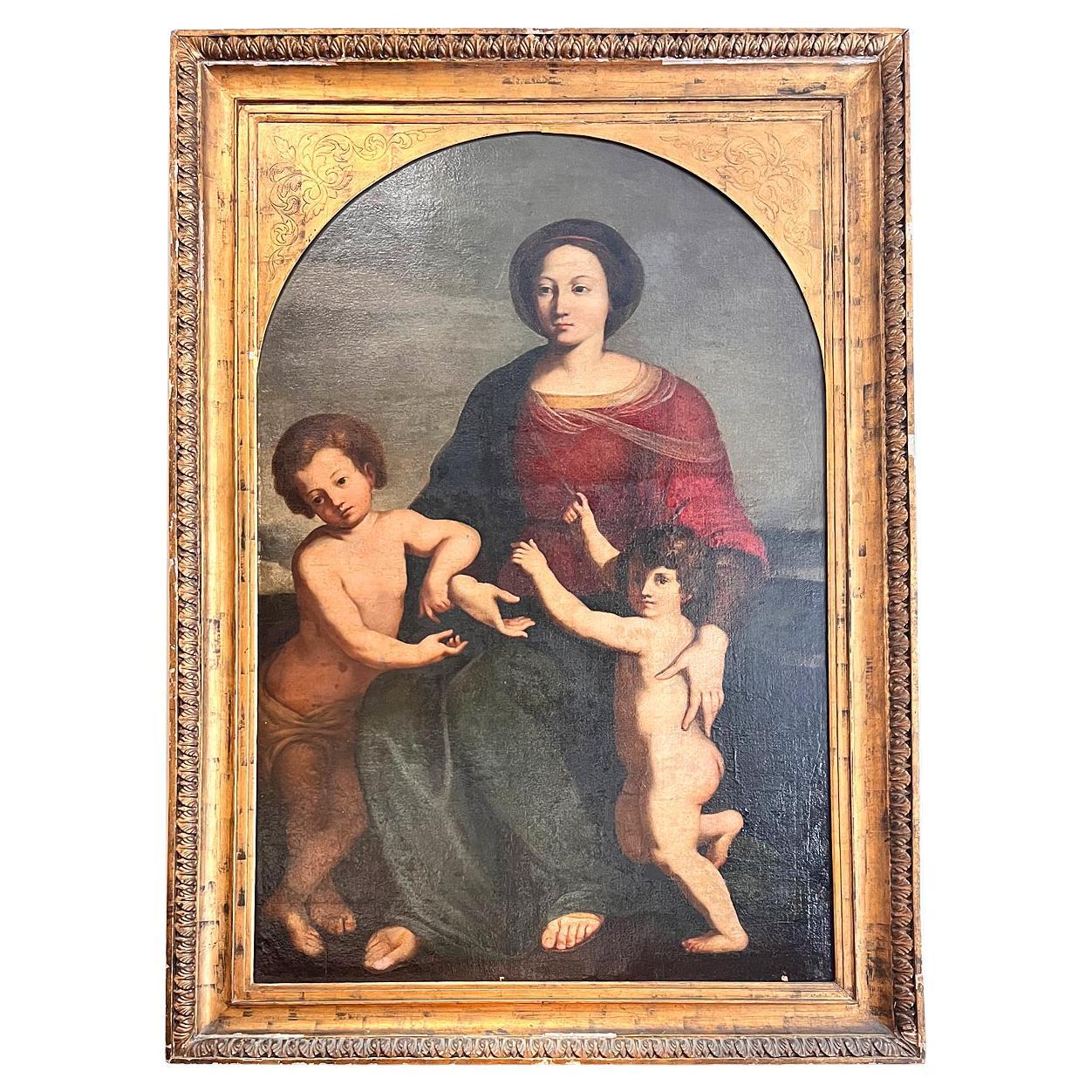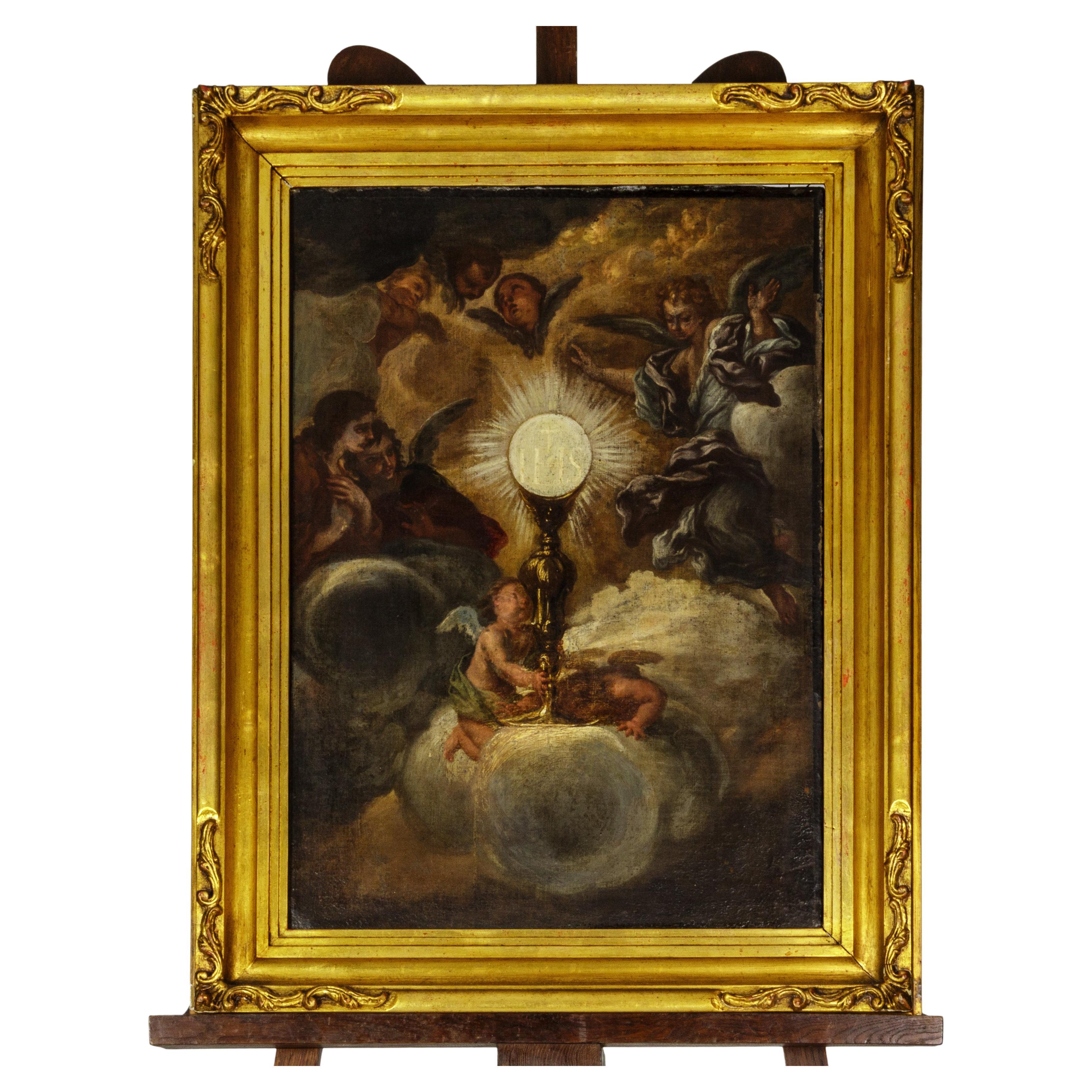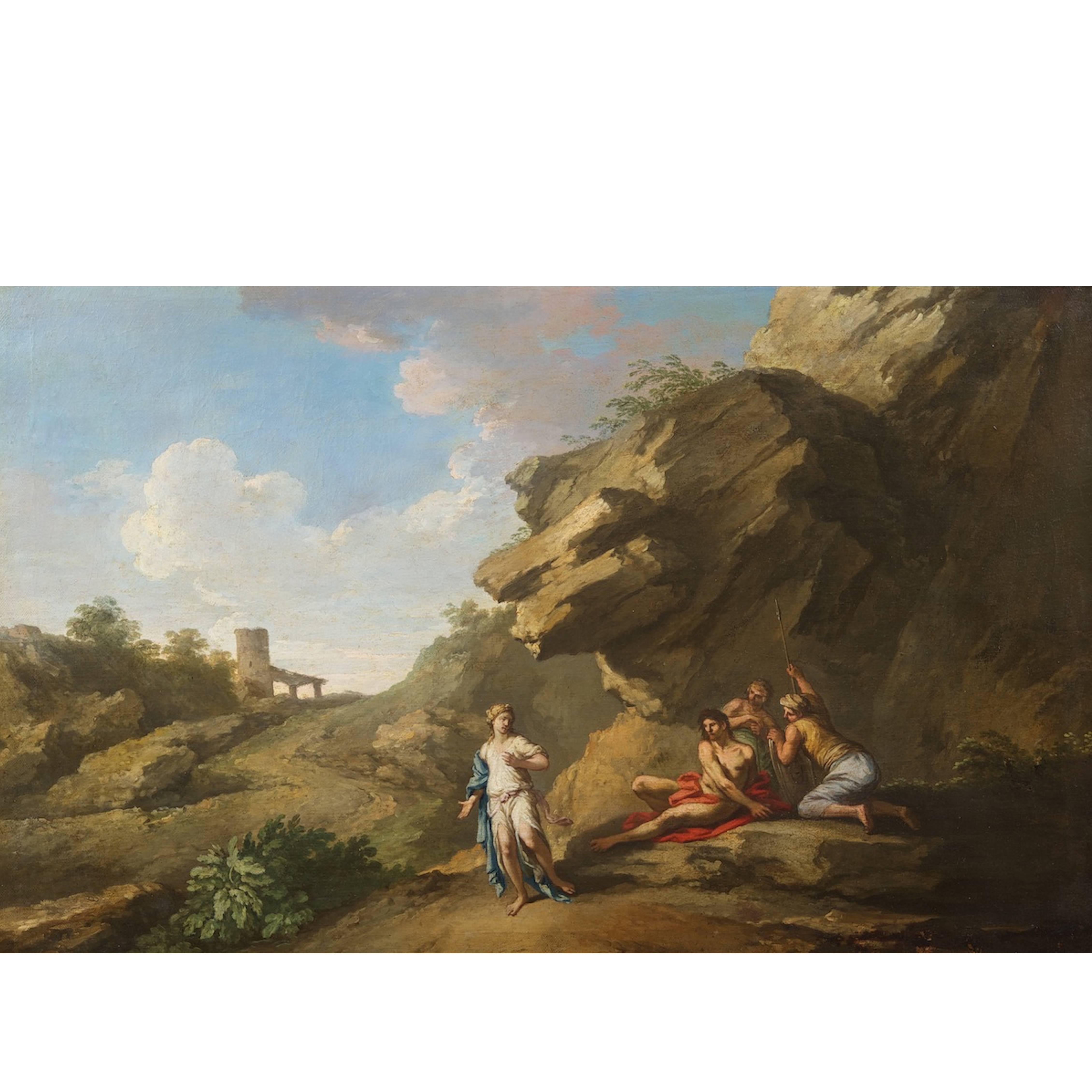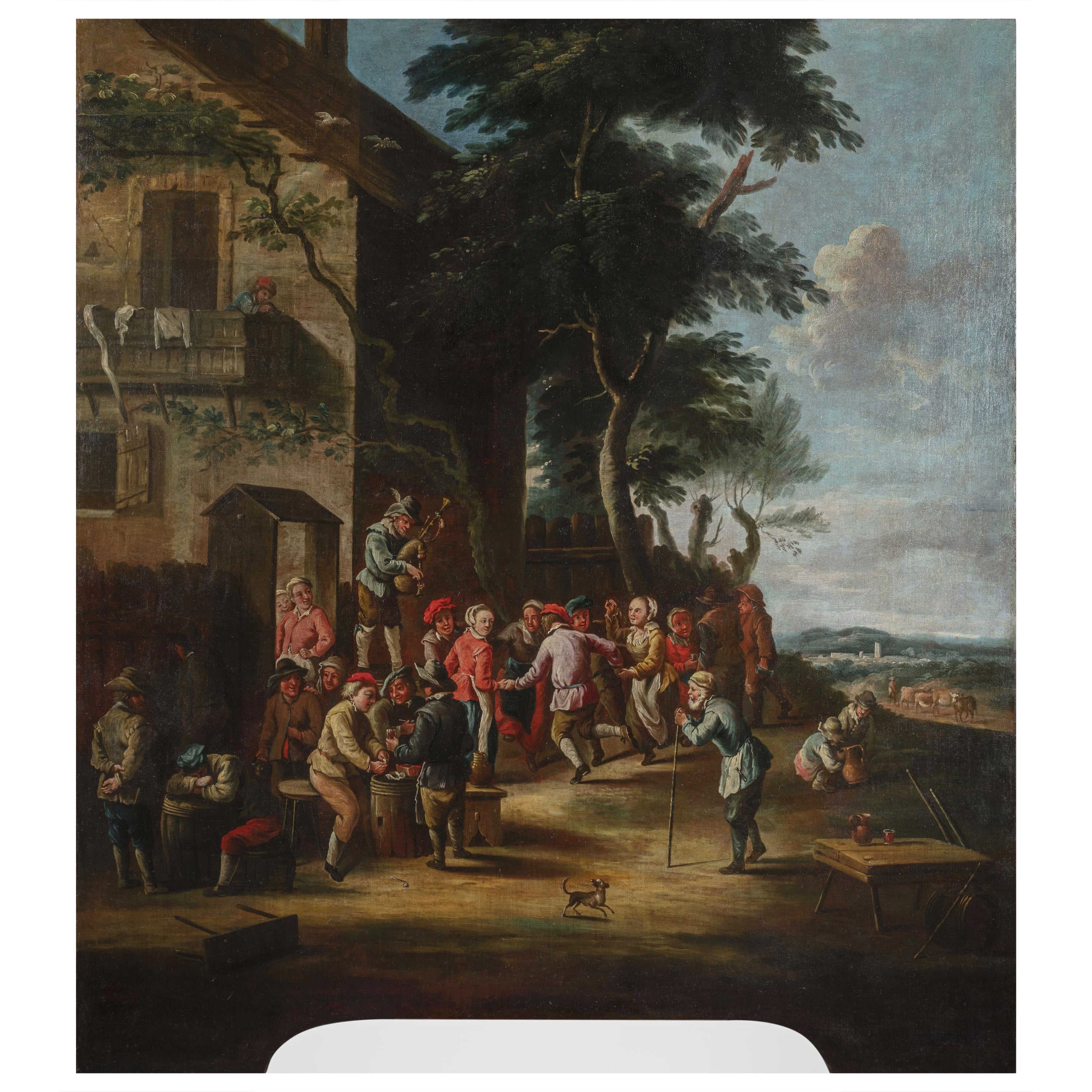Items Similar to 18th Centuy, Italian Painting with Landscape by Giovanni Battista Colomba
Want more images or videos?
Request additional images or videos from the seller
1 of 17
18th Centuy, Italian Painting with Landscape by Giovanni Battista Colomba
About the Item
Giovanni Battista Innocenzo Colomba (1713 – 1793)
Landscape with figures
Oil on canvas, Frame H 102 x L 112 x P 8; canvas H 77 x L 87
The valuable painting, attributable to the painter Giovanni Battista Innocenzo Colomba (1713 - 1793), depicts a wooded landscape animated by characters. At the center of the canvas is a bridge with two arches from which flow lively waterfalls, characteristic of the works of the painter. In addition to the bridge, built of bricks and crossed by some travelers with steeds, the landscape opens, hilly, and then be bordered by large mountains that clear away. A fortress shows a turreted castle overlooking the void. In the foreground, along a path, several people are caught and portrayed in their daily lives. From the left, a couple of travellers take a break, while a few others, accompanied by horses, continue their journey. In the middle two peasants, she with a wicker basket on her head full of wheat and a scythe in her hand, he sitting, with a stick and a pannier on his shoulders, entertain themselves in a dialogue, while on the right two humble parents pray before a child in need of care. The dramatic scene, full of pathos, exalted by the gestures of comfort and concern of two people who flock, are joined by a couple of friars through a gesture of blessing, reminiscent of the power of faith and hope. It is therefore a work of fine workmanship, very pleasant on the aesthetic level and certainly decorative. However, the landscape and the many characters depicted conceal a richer and more vigorous message of faith that the author develops with discretion and descriptive force. In the work is immediately recognizable the style that distinguishes the works of the mature painter, in which the lively and bright palette is accompanied by fine brushstrokes to form landscapes that oscillate between Rococo and Neoclassicism.
Giovanni Battista Innocenzo Colomba (1713 - 1793) was born in Arogno (Canton Ticino), in a family of painters, plasterers and architects whose founder is Andrea Colomba (1567-1627). He learned painting from his uncle, Luca Antonio Colomba, a painter at the Wüttemberg court in Germany, and around 1737 he was an independent painter in Mainz, where he painted several frescoes and decorations. It is probable that he completed his training at the Academy of Vienna, in those years a fundamental centre of aggregation and cultural exchange. He had an intense activity as a set designer and decorator at various princes. In 1741 in Frankfurt he decorated, with squares and allegorical paintings, the ceiling of Römer’s "Imperial Staircase" (destroyed in World War II), on the occasion of celebrations for the coronation as emperor of Charles VII (12 February 1742). In 1748 he was called to Hamburg where he worked in Schleswig-Holstein (large fresco, in the church of Uetersen with Glorification of the Trinity). In Hanover he became court painter to George II. In 1751 he passed into the service of the Duke of Württemberg. In Ludwigsburg and Stuttgart he had an important position for the grand court festivals.
He is a professor at the Stuttgart Academy of Arts founded by Carlo Eugenio in 1761. By 1763 he worked in Italy: on that date the new theatre was inaugurated in Como, in which Colomba worked for many scenes. In the same city he painted the choir of St. James and the church of the seminary Benzi.
The painter moved to Turin where he took the place of the Galliari brothers signing in 1769 the capitulation with the Society of the Knights that administered the Teatro Regio. Relations with the Turin theatre, where he worked for two seasons until 1771, were however studded with endless quarrels. In the years 1774-1780 he is documented in London as a landscape and stage painter at the King’s Theatre and in 1775 he set up a theatre at Weston Hall for Sir Henry Bridgeman. His stay in London allowed him an early opening towards the pre-Romanesque aesthetic, recognizable in the landscapes he made at that time. From 1780 he settled permanently in Arogno and in 1792 he painted in the church of S. Carlo in Poschiavo in Valtellina three canvases with S. Remigio baptizing Clodoveo, S. Rocco between the plague and the Annunciation. In these last works his style oscillates between classicist aesthetics and that still baroque, obviously in tune with the tastes of the client.
According to tradition he died in Arogno in 1793.
The canvas object of this study presents the unmistakable stylistic manner of the artist. The work can be flanked by several paintings signed or returned with certainty to the production of Giovanni Battista Innocenzo Colomba, where we find the same treatment of atmospheric light, the fronds of trees, of the scenographic compositional system and of great depth of perspective. Equally consistent is the color used, particularly recognizable in reds and greens, in browns and blues.
Several elements return, such as the presence of water, of the wide green fronds described with luministic research and of the lively figures portrayed never in static poses but carefully in capturing a precise moment, giving movement and pathos to what is depicted.
We apologize for any translation errors from Italian. Please contact us to have the expertise in Italian.
- Dimensions:Height: 40.16 in (102 cm)Width: 44.1 in (112 cm)Depth: 3.15 in (8 cm)
- Style:Rococo (Of the Period)
- Materials and Techniques:
- Place of Origin:
- Period:
- Date of Manufacture:Mid-18th Century
- Condition:Wear consistent with age and use.
- Seller Location:IT
- Reference Number:1stDibs: LU4405235391842
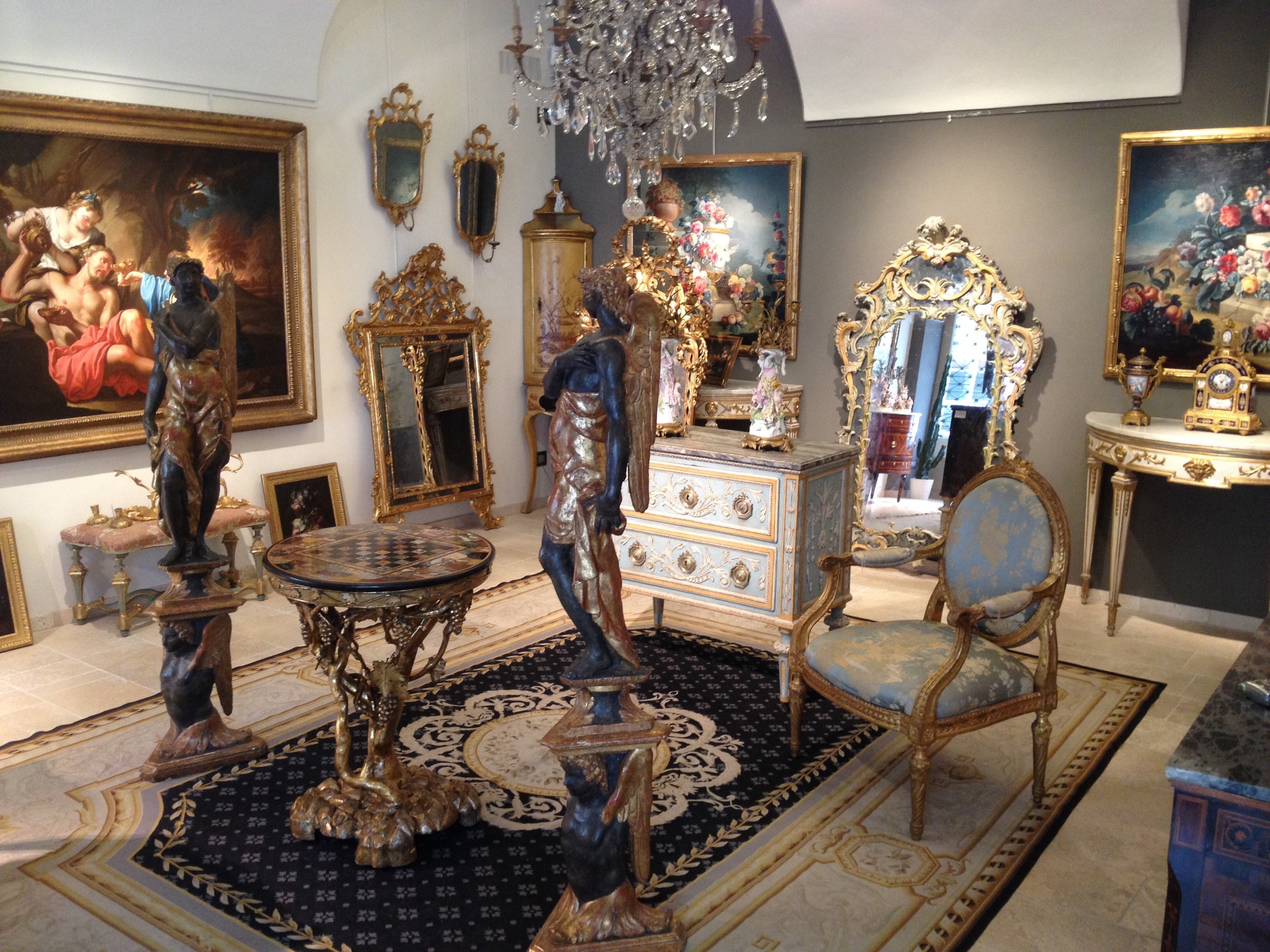
About the Seller
5.0
Gold Seller
These expertly vetted sellers are highly rated and consistently exceed customer expectations.
Established in 1980
1stDibs seller since 2019
41 sales on 1stDibs
Typical response time: 1 hour
- ShippingRetrieving quote...Ships From: Italy
- Return PolicyA return for this item may be initiated within 7 days of delivery.
More From This SellerView All
- 18th Century, Italian Painting Depicting Landscape with Watermill and CharactersLocated in IT18th century, Italian painting depicting landscape with watermill and characters Oil on canvas; Measurements: frame cm L 103.5 x H 127 x P 5; painting L 93 x H 117.5 The painting...Category
Antique Mid-18th Century Italian Rococo Paintings
MaterialsCanvas
- 18th Century, Italian painting Depicts Bambocciata by Giovanni Michele GraneriLocated in ITGiovanni Michele Graneri (Italy, Turin 1708-1762) Bambocciata (Farmers dancing in front of the inn) The painting, made in oil on canvas, depicts a moment of celebration where some p...Category
Antique Mid-18th Century Italian Baroque Paintings
MaterialsCanvas
- 18th Century, Italian Oil on Canvas Painting with Landscape with RuinsLocated in IT18th century, Italian oil on canvas painting with landscape with ruins Measures: only the canvas cm W 97.5 x H 108; with the frame cm W 103.5 x H 114 x D 5 The fine oil on canv...Category
Antique 18th Century Italian Baroque Paintings
MaterialsCanvas
- 18th Century, French Painting with Landscape with RuinsLocated in IT18th century, French Painting with Landscape with Ruins Measures: frame cm L 165 x H 95 x P 10; canvas cm L 142 x H 71 This painting depicti...Category
Antique Late 18th Century French Baroque Paintings
MaterialsCanvas
- 18th Century, Two Still Lifes with Flowers and Fruits by Italian PaintingsLocated in ITPiedmontese painter of the second half of the 18th century Two "Still Lifes with composition of flowers, fruits and mushrooms" Measurements: Frames: cm W 63 x H 74 x D 8.5 frames...Category
Antique 18th Century Rococo Paintings
MaterialsCanvas, Giltwood
- 18th Century, Italian Painted with Still Life by Francesco LavagnaBy Francesco LavagnaLocated in IT18th Century, Italian painted with still Life by Francesco Lavagna. The fine and imposing painting, accompanied by a frame in carved and gilded wood, depicts a sumptuous composition...Category
Antique Early 18th Century Italian Rococo Paintings
MaterialsCanvas
You May Also Like
- San Pietro by Giovanni Battista Piazzetta’s follower, Venice 18th CenturyLocated in Spinea, VenetoSan Pietro by Giovanni Battista Piazzetta’s follower – Venice XVIII century The painting is a very-well executed replica of the famous original by Giovan...Category
Antique 18th Century Italian Paintings
MaterialsCanvas
- Mid 18th Century, Giovanni Battista Salvi 'Sassoferrato' School, MaternityLocated in Firenze, FILarge oil painting on canvas depicting the Madonna with Child and San Giovannino within a carved and gilded wooden frame. The subject is particular as it leaves the classic canons of the representation of Maternity by presenting a Madonna without a halo. Attributable to the School of Giovanni Battista Salvi...Category
Antique Mid-18th Century Italian Paintings
MaterialsCanvas, Giltwood
- Baroque Jesus Painting By Giovanni Battista Gaulli, 17th CenturyBy Giovanni Battista GaulliLocated in Lisbon, PTA painting, prior to 1678, from a famous fresco of the Triumph of the Name of Jesus from the Gesù Church in Rome, completed in 1684, attributed to the Old Master Painter Giovanni Battista Gaulli, also known as Baciccio or Baciccia an Italian master of the 17th Century. Gaulli paintings and frescoes are visible at the roman churches of Santa Agnese...Category
Antique 17th Century Italian Baroque Paintings
MaterialsCanvas
- Andrea Locatelli, Italian/Roman Landscape Painting with Figures, 18th CenturyLocated in CHA Roman landscape oil on canvas painting with figures by Andrea Locatelli (Roma 1693-1741) Locatelli was amongst the group of landscape painters in R...Category
Antique Early 18th Century Italian Rococo Paintings
MaterialsCanvas
- 18th Century Lying Female Figure Painting by Giovanni Domenico MolinariLocated in Milan, ITGiovanni Domenico Molinari (Caresana, 1721 - Turin, 1793) Lying Female figure Oil on canvas, cm 46 x. 31 - With frame, cm 56 x 42 The present painting is connected by style and treated subject, in this case a young girl lying in an idyllic landscape, to the production of small pictures of pastoral subject of the Piedmontese painter Giovanni Domenico Molinari (Caresana, 1721 - Turin, 1793). Molinare was born in Caresana (Vercelli) on 19 July 1721 but after losing both his parents he moved to Turin. Here he became, from 1736, a pupil of the Academy of Drawing founded by the painter Claudio Francesco Beaumont (Turin, 4 July 1694 - Turin, 21 June 1766) where he remained as a pensioner until December 1755. Molinari was immediately engaged in the translation of the master’s sketches on cardboard used for the Regia manufacture of tapestries. His early success on the Turin art scene is confirmed by the fact that he joined the Compagnia di San Luca in 1756. In 1751 he married Margherita Peiroleri, whose brothers Pietro (engraver) and Nicolò (painter) also attended the school. Remained widower count two other marriages first with Lucrezia Elisabetta Burzio and then in 1770 with Domenica Maria Ferrero. On the death of the master in 1766 Molinari, considered by his contemporaries to be the most faithful interpreter of the master and for his elegant and Arcadian style, which clearly interprets the aesthetic taste of the court, was called to finish the works that remained unfinished, such as the altarpiece for the church of Santa Maria della Scala in Moncalieri depicting the Assumption venerated by Blessed Bernard of Baden and Saint Anthony. Molinari was also well praised by critics and Abbot Lanzi highlighted the quality of the production of historical and mythological subject for the rigorous post-marattesco classicism. In Turin he worked for Vittorio Amedeo III of Savoy as a portrait painter, executing for him eleven canvases (between 1774 and 1775), but, since 1745, he also supplied tapestry cartoons to the local Fabbrica, of which, in 1766, he became director. The production of paintings of sacred subjects is also lively, especially used in the decoration of the churches of the capital as the Assumption for the Hotel of Virtue and San Pietro Regalado and San Benedetto il Moro for Santa Maria degli Angeli ( Torino) He also painted tempera and oil cartoons for the same church, on the occasion of the beatification of Pacifico da San Severino (1787) and, for that of San Francesco di Paola, when Gaspare de Bono...Category
Antique 18th Century Italian Paintings
MaterialsCanvas
- 17th C Neapolitan School Painting Oil Canvas Old Master Mola Giovanni BattistaBy MollaLocated in West Hollywood, CA17th century Neapolitan School Painting Oil Canvas Old Master Mola Giovanni Battista painting of a boy with a bird, in original carved giltwood frame. The cloudy blue skies and trees in the background gives it the sense of depth. This painting is the perfect magic touch to a library, a bedroom wall, living dining room. To decorate the wall on top of a console or credenza. On top of a fireplace mantel (fireplace). Neapolitan painting of the early seventeenth century is characterized by dramatic expression, emphatic naturalism, and intense chiaroscuro derived from the profound influence of Caravaggio (1571–1610), who spent a number of his later years in the port city. The younger Neapolitan artists were also influenced by the classicism of Guido Reni. Naples Napoli was governed for decades by wealthy Spanish viceroys and the Austrian Hapsburgs. Ribera’s naturalistic style resonated throughout the new work produced by the young Neapolitan painters such as Luca Giordano painting through an amplified sense of color and a particular sensitivity toward light Neoclassicism Romanticism. Antique Dealer Los Angeles CA West Hollywood Beverly Hills Gallery Melrose La Cienega. Interior decor and Garden Landscape elements. Collectors and decorative objects. As a house warming gift idea for history lovers and collectors Mola, Giovanni Battista a French painter of the Bolognese school, was born about 1616 amd doed in rome 1661, and was a scholar of Albano. Student of Simon Vouet, in Italy he met his Namesake The Great Pietro...Category
Antique 17th Century Italian Renaissance Paintings
MaterialsPlaster, Wood, Giltwood, Canvas
